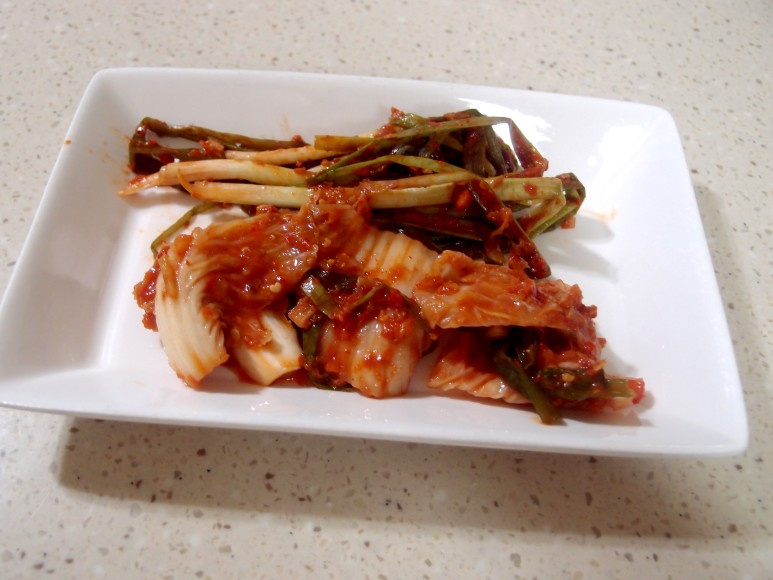Flavorful Aged Scallion Kimchi & Fresh Cabbage Kimchi
#ScallionKimchi #HowToMakeScallionKimchi #LeekKimchi #QuickCabbageKimchi #FreshKimchiRecipe

This recipe introduces an easy way to make delicious scallion kimchi using the leftover seasoning from freshly made ‘mat kimchi’ (delicious kimchi), which is a type of quick, fresh kimchi. You can save time and effort by making both mat kimchi and scallion kimchi simultaneously. First, prepare the mat kimchi, then use the remaining seasoning to coat the scallions for a delightful scallion kimchi. For detailed instructions on making mat kimchi, please refer to my previous post (https://blog.naver.com/koreastencil/223212137095). This recipe is a triple treat, incorporating fresh scallions and aromatic leeks for a rich and satisfying flavor.
Kimchi Ingredients- 400g Scallions
- 6 Leeks
- 2/3 portion of Kimchi Seasoning for Mat Kimchi
Kimchi Seasoning Ingredients- 3 cups Sweet Rice Porridge (Japssalpul)
- 3 cups Gochugaru (Korean chili flakes, paper cup)
- 5 Tbsp Cheongyang Gochugaru (extra spicy chili flakes)
- 8 Tbsp Minced Garlic
- 2 Leeks (finely chopped)
- 2 Tbsp Minced Ginger
- 1 Onion (pureed)
- 1 Apple (pureed)
- 3 Tbsp Saeujeot (fermented salted shrimp, finely minced)
- 5 Tbsp Fish Sauce (Myeolchi aekjeot)
- 3 Tbsp Fish Sauce (Galchi aekjeot)
- 4 Tbsp Plum Extract (Maesil aek)
- 500ml Anchovy Broth
- 3 cups Sweet Rice Porridge (Japssalpul)
- 3 cups Gochugaru (Korean chili flakes, paper cup)
- 5 Tbsp Cheongyang Gochugaru (extra spicy chili flakes)
- 8 Tbsp Minced Garlic
- 2 Leeks (finely chopped)
- 2 Tbsp Minced Ginger
- 1 Onion (pureed)
- 1 Apple (pureed)
- 3 Tbsp Saeujeot (fermented salted shrimp, finely minced)
- 5 Tbsp Fish Sauce (Myeolchi aekjeot)
- 3 Tbsp Fish Sauce (Galchi aekjeot)
- 4 Tbsp Plum Extract (Maesil aek)
- 500ml Anchovy Broth
Cooking Instructions
Step 1
First, prepare the napa cabbage for the mat kimchi by cutting 6 heads into bite-sized pieces. Rinse the cut cabbage thoroughly under running water and drain well.

Step 2
Add coarse sea salt to the drained cabbage and mix evenly. Cover the container and let it wilt until the cabbage softens. The cabbage is ready when the stalks are pliable and it has shrunk significantly.

Step 3
While the cabbage is salting, prepare julienned radish for the mat kimchi.

Step 4
Trim and wash the chives, then drain them. Cut them into approximately 4cm lengths. Also, wash and drain the scallions for the scallion kimchi.

Step 5
Check the saltiness of the well-salted cabbage. If it’s too salty, rinse it several times to adjust. If the saltiness is just right, rinse it twice and squeeze out excess water. Add the julienned radish and chives to the drained cabbage and mix well.

Step 6
Now, let’s make the key kimchi seasoning. First, cook the sweet rice porridge and let it cool. While it cools, puree the onion and apple. Once the sweet rice porridge has cooled, combine it with gochugaru, Cheongyang gochugaru, the pureed onion and apple, minced garlic, minced ginger, chopped leeks, minced saeujeot, both types of fish sauce, plum extract, and anchovy broth. Mix everything thoroughly until smooth. It’s best to make this seasoning mixture a day in advance and let it ferment in the refrigerator for a deeper, more savory flavor. Add 2/3 of this prepared seasoning to the cabbage mixture and mix well. The remaining 1/3 will be used for the scallion kimchi.

Step 7
This mixture, as is, can be enjoyed as a fresh ‘geotjeori’ (fresh kimchi). If allowed to ferment, it will become delicious, aged mat kimchi.

Step 8
Pile the prepared scallions generously on top of the well-mixed mat kimchi. Then, spread the reserved kimchi seasoning over the scallions and coat them evenly. Adding 6 large leeks, cut into segments, at this stage will create a leek kimchi. If the seasoning seems plentiful, feel free to add more leeks. Let it ferment at room temperature for about a day and a half, then store it in the kimchi refrigerator to chill. It will be at its best after about two days in the fridge.

Step 9
The well-fermented scallion kimchi and mat kimchi are now ready. The leeks have also matured beautifully, adding a wonderful depth of flavor. This kimchi pairs exceptionally well with rich, fatty meats like samgyeopsal (pork belly) or gopchang (intestines).

Step 10
Here are the beautifully aged scallion kimchi and mat kimchi. They are complete! This kimchi is so satisfying that it can turn a simple bowl of rice into a complete, hearty meal. Although the scallions I used were not as plump as I had hoped, both the leek kimchi and the mat kimchi turned out wonderfully. I enjoyed a clean and satisfying meal with these kimchis and a bowl of bean sprout soup.




